
Scydmaeninae are a subfamily of small beetles, commonly called ant-like stone beetles or scydmaenines. These beetles occur worldwide, and the subfamily includes some 4,500 species in about 80 genera. Established as a family, they were reduced in status to a subfamily of Staphylinidae in 2009

Baltic amber or succinite is amber from the Baltic region, home of its largest known deposits. It was produced sometime during the Eocene epoch, but exactly when is controversial. It has been estimated that this forested region provided the resin for more than 100,000 tons of amber. Today, more than 90% of the world's amber comes from Kaliningrad Oblast of Russia. It is a major source of income for the region; the local Kaliningrad Amber Combine extracted 250 tonnes of it in 2014 and 400 tonnes in 2015.
Psyllototus is an extinct genus of flea beetles described from the late Eocene Rovno amber of Ukraine, and from the Baltic amber of Russia and Denmark. It was named by Konstantin Nadein and Evgeny Perkovsky in 2010, and the type species is Psyllototus progenitor. In 2016, a newly described extant flea beetle genus from Bolivia, Chanealtica, was found to be most similar to Psyllototus, based on the characters available for observation.
Epiborkhausenites is an extinct genus of moth in the concealer moth family Oecophoridae and containing a single species Epiborkhausenites obscurotrimaculatus. The species is known only from Middle Eocene, Bartonian stage, Baltic amber deposits near the town of Palanga in Lithuania.

Yantaromyrmex is an extinct genus of ants first described in 2013. Members of this genus are in the subfamily Dolichoderinae of the family Formicidae, known from Middle Eocene to Early Oligocene fossils found in Europe. The genus currently contains five described species, Y. constrictus, Y. geinitzi, Y. intermedius, Y. mayrianum and Y. samlandicus. The first specimens were collected in 1868 and studied by Austrian entomologist Gustav Mayr, who originally placed the fossils in other ant genera until the fossils were reviewed and subsequently placed into their own genus. These ants are small, measuring from 4 to 6 mm in length and can be characterized by their trapezoidal shaped head-capsules and oval compound eyes that are located slightly to the rear of the capsules midpoint, with no known ocelli present.
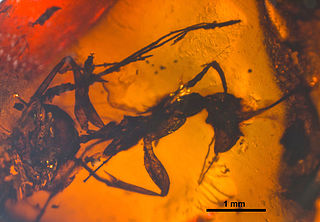
Zherichinius is an extinct genus of ants in the subfamily Dolichoderinae known from fossils found in amber from the Middle Eocene of Sakhalin island Far eastern Russia and Bitterfeld, Germany. At the time of description the species Zherichinius horribilis and Zherichinius rapax were two of eight ant species known from Sakhalin fossils.

Bradoponera is an extinct genus of ant in the Formicidae subfamily Proceratiinae, and is one of four genera of the subfamily. The genus contains four described species Bradoponera electrina, Bradoponera meieri, Bradoponera similis, and Bradoponera wunderlichi. The species are known from several Middle Eocene amber fossils which were found in Europe.
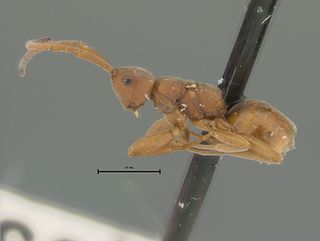
Embolemidae is a family of small solitary parasitoid wasps with around 70 species in 2 genera distributed around the world. The few species whose biology is known are parasites on planthopper nymphs of the families Achilidae and Cixiidae. There is debate regarding the status of the genus named Ampulicomorpha by Ashmead in 1893, generally considered now to be a junior synonym of Embolemus (e.g.,), though some authorities dispute this (e.g.,)
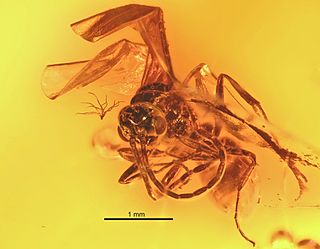
Pachycondyla succinea is an extinct species of ant in the formicid subfamily Ponerinae described from fossils found in Europe. P. petrosa is one of three middle Eocene Pachycondyla species found in Baltic amber.

Alicodoxa is an genus of extinct planthoppers in the family Dictyopharidae. It contains a single described species, Alicodoxa rasnitsyni, known from several Late Eocene fossils found in Europe.

Nylanderia pygmaea is an extinct species of formicid in the ant subfamily Formicinae known from fossils found in the Prussian Formation of the Baltic region.
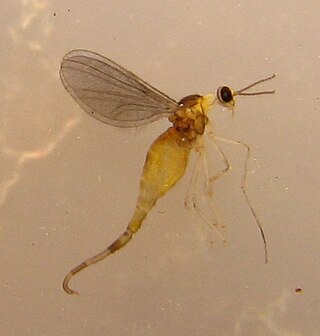
Winnertziinae is a subfamily of gall midges and wood midges in the family Cecidomyiidae.
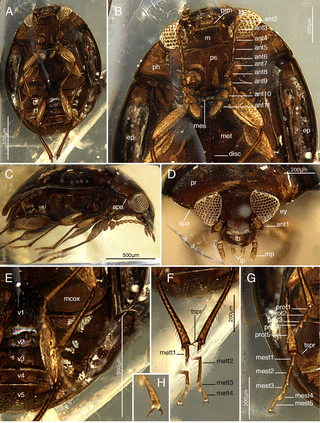
Cyclaxyridae are a family of beetles in the superfamily Cucujoidea. The only living genus is Cyclaxyra, with two species endemic to New Zealand. Other species have been named from fossils. They are also known as sooty mould beetles due to the association of Cyclaxyra with sooty mould. The extant species are mycophagous, feeding on spores, conidia, and hyphae.
Proneuronema is an extinct genus of lacewings in the neuropteran family Hemerobiidae known from fossils found in amber. The genus currently contains three species, P. gradatum and P. minor from Baltic amber and P. sidorchukae from Rovno amber. A Ypresian fossil from Washington state was initially also placed within the genus, having been moved from its original placement as Cretomerobius wehri, but was subsequently moved to the separate genus Archibaldia by Vladimir Makarkin (2023).
This paleoentomology list records new fossil insect taxa that were to be described during the year 2021, as well as notes other significant paleoentomology discoveries and events which occurred during that year.
This paleoentomology list records new fossil insect taxa that are to be described during the year 2022, as well as notes other significant paleoentomology discoveries and events which occurred during that year.
This list of 2023 in paleoentomology records new fossil insect taxa that are to be described during the year, as well as documents significant paleoentomology discoveries and events which occurred during that year.
This list of 2024 in paleoentomology records new fossil insect taxa that are to be described during the year, as well as documents significant paleoentomology discoveries and events which occurred during that year.

The Mezhigorje Formation is a geologic formation in Belarus and Ukraine that dates to the Early Oligocene. Rovno amber is found in this formation and it has been studied since the 1990s.
The Obukhov Formation is a geologic formation in Belarus and Ukraine that dates to the Late Eocene; the Obukhov Formation is equivalent to the Prussian Formation of Russia.

















